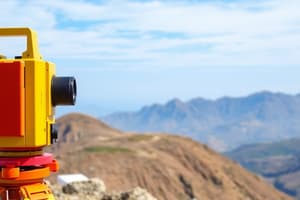Podcast
Questions and Answers
Who divided the land of Egypt into plots for the purpose of taxation?
Who divided the land of Egypt into plots for the purpose of taxation?
Sesostris
What were the early surveyors in ancient Egypt called?
What were the early surveyors in ancient Egypt called?
rope-stretchers
What important treatise did HERON write related to surveying?
What important treatise did HERON write related to surveying?
Dioptra
What is a diopter?
What is a diopter?
Early civilizations assumed the Earth was a spherical surface.
Early civilizations assumed the Earth was a spherical surface.
Who was among the first to compute the Earth's dimensions?
Who was among the first to compute the Earth's dimensions?
What method did Eratosthenes use to calculate the Earth's circumference?
What method did Eratosthenes use to calculate the Earth's circumference?
What is surveying?
What is surveying?
Surveying is only concerned with land measurements above the Earth's surface.
Surveying is only concerned with land measurements above the Earth's surface.
Flashcards
Sesostris
Sesostris
The ruler who divided Egypt's land for taxation.
Rope-stretchers
Rope-stretchers
Early surveyors in ancient Egypt responsible for measuring land.
Dioptra
Dioptra
An important surveying treatise written by Heron.
Diopter
Diopter
Signup and view all the flashcards
Eratosthenes
Eratosthenes
Signup and view all the flashcards
Calculating Earth's circumference
Calculating Earth's circumference
Signup and view all the flashcards
Surveying
Surveying
Signup and view all the flashcards
Land measurements
Land measurements
Signup and view all the flashcards
Early civilizations' belief
Early civilizations' belief
Signup and view all the flashcards
Study Notes
Introduction to Surveying and Mapping
- Surveying and mapping are essential disciplines in understanding and managing land.
- The course is offered by the Department of Geodetic Engineering at Caraga State University.
History of Surveying
- Herodotus reported land division in ancient Egypt by Sesostris around 1400 B.C. for taxation purposes.
- Early surveyors, termed "rope-stretchers," used ropes with markers to measure land areas impacted by Nile floods.
- Heron, around 120 B.C., made significant contributions by applying scientific principles to surveying, authoring important texts like "Dioptra."
- The diopter, an early surveying instrument mentioned in Heron's writings, was used for angle measurements.
- Early beliefs depicted Earth as flat; observations of lunar shadows and ships disappearing over the horizon led to the understanding of Earth's curvature.
- Eratosthenes, a Greek scholar around 200 B.C., was a pioneer in calculating Earth's dimensions by measuring the length of shadows to determine its circumference at approximately 25,000 miles.
Surveying Concepts
- Surveying is defined as applied mathematics focused on measuring areas, lengths, directions, and contours of the Earth's surface.
- It combines science, art, and technology to ascertain the relative positions of points located above, on, or beneath the Earth.
- Specialized equipment and mathematical techniques are utilized to establish angular and linear measurements essential for determining land features and layouts.
Intended Learning Outcomes
- Students will gain an understanding of the history and principles of surveying.
- Differentiating geomatics and its various disciplines, including mapping and surveying, is a key focus.
- Students will learn about the applications, types, and legal aspects related to surveys.
- Basic operations and methods of surveying will be covered comprehensively throughout the course.
Studying That Suits You
Use AI to generate personalized quizzes and flashcards to suit your learning preferences.




